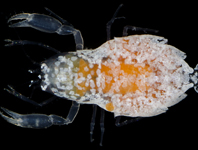Abstract
Two new species of the cestode genus Caulobothrium, collected from the duckbill eagle ray, Aetomylaeus bovinus, off Senegal, are described. Although postulated as sister taxa in an earlier molecular phylogenetic analysis, Caulobothrium multispelaeum n. sp. and Caulobothrium katzi n. sp., respectively, are among the smallest and largest members of the genus. The smaller species is unique among its congeners in possessing unusual medial longitudinal grooves along the dorsal and ventral surfaces of its strobila that develop into a tandem series of elliptical apertures on the posterior proglottids. The inner surfaces of these apertures stained positively with McManus’ periodic acid Schiff in a manner similar to that seen in members of the distantly related lecanicephalidean genus Elicilacunosus. The larger species differs from its congeners in size, number of proglottids, and arrangement of bothridial loculi. Both new species were found to possess a small apical sucker on the anterior margin of each of their bothridia. Scanning electron microscopy (SEM) and frontal sections of a bothridium of Caulobothrium tetrascaphium suggests that this species also bears an apical sucker. Examination of the hologenophore of the species provisionally referred to as Caulobothrium n. sp. 5 in the earlier molecular analysis indicates it is conspecific with the recently described Caulobothrium pedunculatum, which was also determined to possess bothridial apical suckers. This leads us to suspect that this feature may be found to occur in all members of the genus. SEM of specimens of Caulobothrium for the first time indicates their bothridial surfaces are covered with filitriches of various sizes but lack spinitriches; spinitriches were seen only on the cephalic peduncle of C. katzi n. sp. The geographic distribution and host associations of Caulobothrium are expanded to include data now available for all species. The diagnosis of the genus is revised to include all of this information.
References
Baer, J.G. (1948) Contributions a l’étude des cestodes des sélaciens. I–IV. Bulletin de la Société Neuchâteloise des Sciences Naturelles, 71, 63–122.
Brooks, D.R., Mayes, M.A. & Thorson, T.B. (1981) Cestode parasites in Myliobatis goodei Garman (Myliobatiformes: Myliobatidae) from Río de la Plata, Uruguay, with a summary of cestodes collected from South American elasmobranchs during 1975–1979. Proceedings of the Biological Society of Washington, 93, 1239–1252.
Bueno, V.M. (2018) Skate tapeworms revisited: A modern approach. Doctoral Dissertation, University of Connecticut, Storrs, Connecticut, 206 pp.
Caira, J.N., Jensen, K. & Healy, C.J. (1999) On the phylogenetic relationships among tetraphyllidean, lecanicephalidean and diphyllidean tapeworm genera. Systematic Parasitology, 42, 77–151.
https://doi.org/10.1023/a:1006192603349
Caira, J.N., Jensen, K. & Healy, C.J. (2001) Interrelationships among tetraphyllidean and lecanicephalidean cestodes. In: Littlewood, D.T.J. & Bray, R.A. (Eds.), Interrelationships of the Platyhelminthes. Taylor & Francis, London, pp. 135–158.
Caira, J.N., Jensen, K. & Ruhnke, T.R. (2017) “Tetraphyllidea” van Beneden, 1849 relics. In: Caira, J.N. & Jensen, K. (Eds.), Planetary Biodiversity Inventory (2008–2017): Tapeworms from Vertebrate Bowels of the Earth. University of Kansas, Natural History Museum, Special Publication No. 25. University of Kansas, Lawrence, Kansas, pp. 371–400.
Caira, J.N., Jensen, K., Waeschenbach, A., Olson, P.D. & Littlewood, D.T.J. (2014) Orders out of chaos—molecular phylogenetics reveals the complexity of shark and stingray tapeworm relationships. International Journal for Parasitology, 44, 55–73.
https://doi.org/10.1016/j.ijpara.2013.10.004
Carvajal, J. (1977) Description of the adult and larva of Caulobothrium myliobatidis sp. n. (Cestoda: Tetraphyllidea) from Chile. Journal of Parasitology, 63, 99–103.
https://doi.org/10.2307/3280111
Chervy, L. (2009) Unified terminology for cestode microtriches: A proposal from the International Workshops on Cestode Systematics in 2002–2008. Folia Parasitologica, 56, 199–230.
https://doi.org/10.14411/fp.2009.025
Coleman, G.M., Beveridge, I. & Campbell, R.A. (2019) Caulobothrium pedunculatum sp. nov., a new species of cestode (Platyhelminthes) parasitic in Australian stingrays (Elasmobranchii: Batoidea). Transactions of the Royal Society of South Australia, 143, 167–174.
https://doi.org/10.1080/03721426.2019.1624932
Euzet, L. (1959) Recherches sur les cestodes tétraphyllides des sélaciens des cotes de France. Docteur dés Sciences Naturelles, Université de Montpellier, Montpellier, 263 pp.
Euzet, L. (1994) Order Tetraphyllidea Carus, 1863. In: Khalil, L.F., Jones, A. & Bray, R.A. (Eds.), Keys to the Cestode Parasites of Vertebrates. CAB International, Wallingford, pp. 149–194.
Healy, C.J. (2006) A revision of selected Tetraphyllidea (Cestoda): Caulobothrium, Rhabdotobothrium, Rhinebothrium, Scalithrium, and Spongiobothrium. Doctoral Dissertation, University of Connecticut, Storrs, Connecticut, 382 pp.
Healy, C.J., Caira, J.N., Jensen, K., Webster, B.L. & Littlewood, D.T.J. (2009) Proposal for a new tapeworm order, Rhinebothriidea. International Journal for Parasitology, 39, 497–511.
https://doi.org/10.1016/j.ijpara.2008.09.002
Koch, K.R., Jensen, K. & Caira, J.N. (2012) Three new genera and six new species of lecanicephalideans (Cestoda) from eagle rays of the genus Aetomylaeus (Myliobatiformes: Myliobatidae) from northern Australia and Borneo. Journal of Parasitology, 98, 175–198.
https://doi.org/10.1645/GE-2798.1
Last, P.R., White, W.T., de Carvalho, M.R., Séret, B., Stehmann, M.F.W. & Naylor, G.J.P. (2016) Rays of the World. Cornell University Press, Ithaca, New York, 790 pp.
https://doi.org/10.1071/9780643109148
Linton, E. (1890) Notes on Entozoa of marine fishes of New England, with descriptions of several new species. Part II. Annual Report of the Commissioner of Fish and Fisheries, 1887, 719–900.
https://doi.org/10.5962/bhl.title.995
Riser, N.W. (1955) Studies on cestode parasites of sharks and skates. Journal of the Tennessee Academy of Science, 30, 265–311.
Sheehan, D.C. & Hrapchak, B.B. (1987) Theory and Practice of Histotechnology. Battelle Press, Columbus, Ohio, 481 pp.
Yamaguti, S. (1934) Studies on the helminth fauna of Japan. Part 4. Cestodes of fishes. Japanese Journal of Zoology, 6, 1–112.


